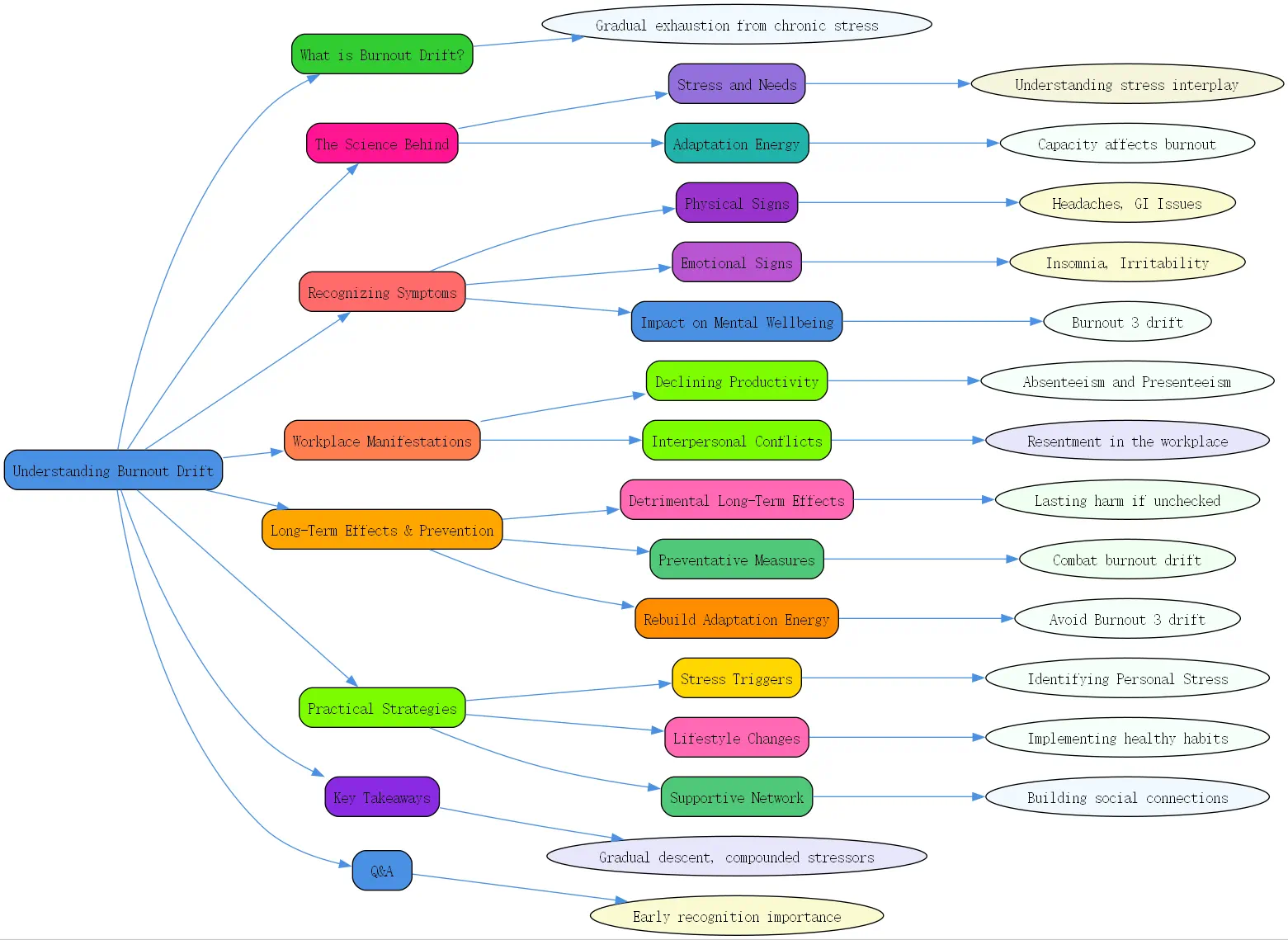Burnout has become an increasingly common challenge, especially amid today’s high-stress environments. Yet, the idea of burnout drift — a gradual, often unnoticed slide toward exhaustion and disengagement — is less understood. This article delves into the intricacies of burnout drift, including stages like burnout drift 2 and burnout 3 drift, explaining how stress accumulates and how to counteract it effectively.
What is Burnout Drift? An Introduction

Burnout drift refers to the slow, progressive descent from healthy functioning to emotional and physical exhaustion caused by chronic stress. Unlike sudden burnout, burnout drift creeps in subtly, making it easy to overlook until the symptoms are pronounced.
Stress plays a pivotal role in this process. Day-to-day pressures, ongoing worries, and unresolved emotional tension gradually wear down one’s resilience. In fact, a recent Gallup poll in 2021 highlighted how U.S. workers experience some of the highest levels of daily stress worldwide, with 57% reporting stress every day—an 8% increase from the previous year. These stressors don’t just emerge overnight but build over time, fueling burnout drift 2, the stage where initial signs become more apparent.

As burnout drift escalates through stages like burnout 3 drift or burnout drift 3, the effects intensify, impacting mental clarity, emotional regulation, and physical well-being. Recognizing these stages early is key to prevention.
The Science Behind Burnout Drift

To truly grasp burnout drift, understanding the interplay between stress and human needs is essential.
Maslow’s Hierarchy of Needs and Burnout Drift
Psychologist Abraham Maslow’s hierarchy of needs provides a framework for understanding how unmet needs drive stress. Imagine a pyramid where basic requirements like food, safety, and social connection must be fulfilled before progressing to higher needs like esteem and self-actualization.
When any level—whether it’s physiological safety or belongingness—is compromised, stress increases. For example, during ongoing isolation or remote work, many miss those essential social interactions that help fulfill belongingness. This unmet need exacerbates stress and accelerates burnout drift progression.
The Body’s Response to Stress: Cortisol and the Fight-Flight-Freeze Mechanism
The body’s biology offers a window into how burnout drift manifests physically. Stress activates the amygdala and hippocampus, brain regions managing emotions and memories. Triggered memories of fear or sadness spark the hypothalamus, which initiates the stress response by signaling the pituitary gland. This cascade results in the release of cortisol, the infamous stress hormone.
Cortisol prepares the body for fight, flight, or freeze responses, but chronic elevation can cause harm, including immune suppression, hypertension, and digestive issues. The sympathetic nervous system dominates under stress, while parasympathetic (“rest and digest”) activity plummets, explaining many physical symptoms linked to burnout drift.

Adaptation Energy: How Individual Capacity Affects Burnout Drift
Everyone’s “adaptation energy” — the capacity to cope with crises and change — varies. We’re born with a finite amount of this energy, which can be depleted by trauma, sustained stress, or poor coping strategies. Once the adaptation energy falters, even minor stressors can trigger significant burnout symptoms.
This concept helps explain why burnout drift affects people differently and why addressing it early is so vital. Recovery involves replenishing this adaptation energy, an essential step to prevent burnout drift 3.
Recognizing the Symptoms of Burnout Drift
Burnout drift manifests through various physical, emotional, and mental signs. Early detection can pave the way for timely intervention.
Physical Signs: Headaches, GI Issues, and Palpitations
Physical symptoms often surface first. Persistent headaches, dry mouth, digestive troubles such as nausea or constipation, and heart palpitations signal the body’s stressed state. These symptoms result from chronic cortisol exposure and an over-activated sympathetic nervous system.
Some individuals experience chest tightness and rapid or irregular breathing. These sensations might mimic a heart attack, leading many to emergency rooms, where stress is often the underlying cause.
Emotional Signs: Insomnia, Addictive Behaviors, and Irritability
On the emotional front, burnout drift leads to insomnia—a vicious cycle because poor sleep both results from and worsens stress. People may increase smoking, alcohol, or other addictive behaviors to cope. Signs like teeth grinding, eye twitches, nail biting, or increased irritability also indicate mounting stress.
Over time, some develop symptoms akin to depression, including loss of interest in activities and difficulty concentrating. Others may feel hypervigilant or experience a distorted sense of reality due to compromised brain function under chronic stress.
Burnout 3 Drift: Impact on Mental Wellbeing
In the burnout 3 drift stage, mental health is significantly impaired. Concentration falters as blood flow diverts from the brain’s frontal lobes. This leads to detachment, reduced motivation, and increased anxiety. Early intervention can prevent burnout from becoming severe or triggering conditions like clinical depression.
Workplace Manifestations of Burnout Drift
Burnout drift affects not only individuals but also workplace dynamics and productivity.
Absenteeism and Presenteeism: Declining Productivity
A telltale sign is absenteeism—employees missing work due to stress-related health problems. Equally detrimental is presenteeism, where employees physically present are mentally disengaged. This reduces output and quality of work, leading to missed deadlines and increased errors.
Interpersonal Conflicts and Resentment
Stress also strains relationships. Increased conflicts with colleagues and growing resentment, often fueled by feelings of inadequate compensation, erode workplace harmony. Those experiencing burnout drift may isolate themselves, further compounding team challenges.
Inability to Delegate and Lack of Communication
An overlooked sign is a growing reluctance to delegate tasks. Stress fosters the need for control, while burnout may cause withdrawal, leading to poor communication and missed feedback opportunities. Individuals under extreme stress may avoid emails or team interactions entirely—hallmarks of drift burnout 3.
Long-Term Effects and Prevention Strategies for Burnout Drift
If left unchecked, burnout drift can produce lasting harm.
The Detrimental Long-Term Effects of Unchecked Burnout Drift
Physically, prolonged cortisol elevation increases risks for hypertension, cardiovascular diseases, and weakened immunity. Mentally, unchecked burnout can lead to serious depression and anxiety, often requiring professional intervention.
Relationships — whether personal or professional — also bear the brunt, as stressed individuals may withdraw or become irritable, damaging communication and support networks.
Preventative Measures to Combat Burnout Drift
Proactive stress management is key. Mindfulness and relaxation techniques such as deep breathing or meditation reduce cortisol levels and restore parasympathetic balance. Improving communication and learning effective delegation foster healthier workplace relationships and workload management.
Setting realistic goals and clear boundaries protects adaptation energy, preventing the gradual slide into burnout.
How to Rebuild Adaptation Energy and Avoid Burnout Drift 3
Restoring adaptation energy involves prioritizing sleep hygiene and self-care. Quality sleep replenishes brain and body function. Seeking support—from mental health professionals or trusted loved ones—offers vital perspective and guidance.
Creating a healthy work-life balance ensures that personal needs are met alongside professional duties, a crucial factor in preventing progression into burnout drift 3.
Practical Strategies for Managing Burnout Drift in Daily Life
Changing habits and mindsets can mitigate burnout drift impacts.
Identifying Personal Stress Triggers
Keep a journal to track situations that spike stress levels. Self-reflection aids in recognizing patterns and developing targeted coping mechanisms. Knowing your unique triggers empowers better management.
Implementing Healthy Lifestyle Changes
Regular exercise invigorates the body and mind, while a balanced diet supports physiological resilience. Limiting stimulants like caffeine and reducing alcohol consumption can improve sleep and overall well-being. Incorporating mindfulness practices nurtures emotional balance.
Building a Supportive Network
Open communication with family, friends, and colleagues reduces isolation. Participating in support groups provides shared understanding, while professional counseling offers tailored tools and interventions.
Key Takeaways for Managing Burnout Drift
- Burnout drift is a gradual descent caused by chronic, compounded stressors.
- Recognize physical symptoms (headaches, palpitations) and emotional signs (insomnia, irritability).
- Burnout drift escalates through stages: burnout drift 2 and burnout 3 drift require increasing attention.
- Workplace signs include absenteeism, presenteeism, conflicts, and communication breakdown.
- Prevention involves stress management, rebuilding adaptation energy, and establishing boundaries.
- Practical daily strategies: journaling, healthy lifestyle, mindfulness, and building support systems.
- Professional help can guide recovery, especially when symptoms overlap with depression or anxiety. For those concerned about these overlaps, resources like depression va rating can offer valuable insights related to mental health assessments.
Q&A: How Can Understanding Burnout Drift Improve Mental Health Management?
Q: Why is it important to recognize burnout drift early, and how does it differ from sudden burnout?
A: Burnout drift is a slow, progressive buildup of stress effects, unlike sudden burnout, which strikes abruptly. Recognizing burnout drift early allows individuals to intervene before reaching severe stages like burnout drift 3, where symptoms significantly impair function. Early awareness supports timely stress management, preserves adaptation energy, and reduces risk of depression or chronic health issues. It also helps workplaces maintain productivity by addressing issues like presenteeism or absenteeism sooner rather than later. Understanding this process leads to more compassionate, effective approaches to mental health, both personally and professionally.




